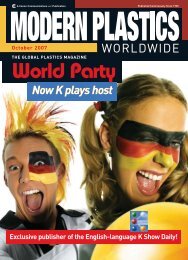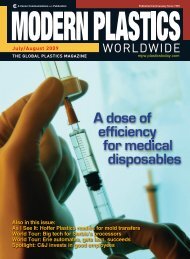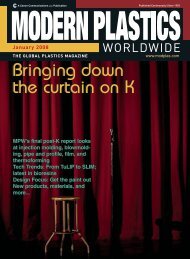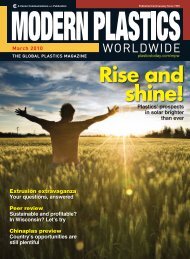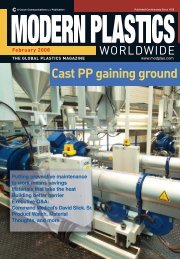amidiq - dae uptlax
amidiq - dae uptlax
amidiq - dae uptlax
Create successful ePaper yourself
Turn your PDF publications into a flip-book with our unique Google optimized e-Paper software.
272<br />
A. Méndez-Zavala et al. / Revista Mexicana de Ingeniería Química Vol. 6, No. 3 (2007) 267-273<br />
de fuentes de nitrógeno presentes en este medio<br />
favorecería la producción de pigmentos.<br />
Conclusiones<br />
La cepa de P. purpurogenum GH-2, es capaz<br />
de crecer y producir pigmentos sobre diferentes<br />
medios, con diversos sustratos, obteniendo diferentes<br />
velocidades de crecimiento relativamente bajas<br />
(0.0903 cm. h -1 , en el medio 1, como máxima<br />
velocidad). En el medio 7 se obtuvo el nivel más alto<br />
de pigmentación aún cuando no tuvo la mejor<br />
velocidad de crecimiento radial. Con este estudio se<br />
puede establecer la necesidad de optimizar el proceso<br />
para la producción de pigmentos de interés industrial<br />
y la caracterización molecular del pigmento, además<br />
de dar una idea del tipo de metabolismo y las<br />
necesidades de nutrientes involucrados en la<br />
producción de pigmentos. El obtener pigmentos de<br />
origen fúngico para su aplicación en diversas<br />
industrias, se hace utilizando tecnologías limpias<br />
mediante procesos biotecnológicos, y con posibles<br />
altos rendimientos, bajos costos y disminución de<br />
tiempo y materias primas; además de no generar<br />
productos de desecho tóxicos. Se han reportado muy<br />
pocos estudios sobre la producción de pigmentos a<br />
partir de Penicillium sp. siendo esta propuesta uno de<br />
los estudios más originales en México para la<br />
exploración y explotación de este tipo oportunidades.<br />
Agradecimientos<br />
Al Centro Internacional de Servicios Fitosanitarios,<br />
S.A. de C.V.<br />
Referencias<br />
Ahmed, Y.G.; Hamdy, M.E.; Mohmed, H.M. y<br />
Esam, Z.A. (2001). Production of natural<br />
microbial pigments using rice grain waste.<br />
P08-23. 11 th World Congress of Food Science<br />
and Technology. Seoul, Korea.<br />
Blanc, P. J., Loret, M. O., Santerre, A. L., Pareilleux,<br />
A., Prome, D., Prome, J. C., Laussac, J. P. and<br />
Goma, G. (1994). Pigments of Monascus.<br />
Journal of Food Science 59 (4), 862-865.<br />
Blanc, P.J.; Loret, M.O. y Goma, G.A. (2001).<br />
Control of the production of metabolites by<br />
Monascus in submerged culture. Tu04-2. 11 th<br />
World Congress of Food Science and<br />
Technology. Seoul, Korea.<br />
Carvalho, J. C., Pandey, A., Babitha, S. and Soccol,<br />
C. R. (2003). Production of Monascus<br />
biopigments: An overview. AgroFOOD<br />
industry hi-tech. 6, 37-42.<br />
Cho, Y. J., Hwang, H. J., Kim, S. N., Song, C. H.<br />
and Yun, J. W. (2002a). Effect of carbon<br />
source and aeration rate on broth rheology and<br />
fungal morphology during red pigment<br />
production by Paecilomyces sinclairii in a<br />
batch bioreactor. Journal of Biotechnology<br />
000, 1-11.<br />
Cho, Y. J., Park, J. P., Hwang, H. J., Kim, S. W.,<br />
Choi, J. W. and Yun, J. W. (2002b).<br />
Production of red pigment by submerged<br />
culture of Paecilomyces sinclairii. Letters of<br />
Applied Microbiology 35, 195-202.<br />
Cruz – Hernández, M., Contreras – Esquivel, J. C.,<br />
Lara, F., Rodríguez, R and Aguilar, C. N.<br />
(2005). Isolation and evaluation of tannin –<br />
degrading strains from the mexican desert.<br />
Journal of Biosciences C. In press.<br />
Domínguez – Espinosa, R.M., Wang, R. and Pacho –<br />
Carrillo, J. D. (2002). Residuos<br />
agroindustriales como materia prima para la<br />
producción de compuestos químicos finos.<br />
Tecnología Ciencia Ed. (IMIQ) 17(2), 77-83.<br />
Durán, N., Teixeira, M. F. S., De Conti, R. and<br />
Espósito, E. (2002). Ecological – Friendly<br />
Pigments From Fungi. Critical Reviews in<br />
Food Science and Nutrition 42 (1), 53-66.<br />
Engstrom, G. W., Stenkamp, R. E., McDorman, D.J.<br />
and Jensen, L. H. (1982). Spectral<br />
Identification, X – ray Structure<br />
Determination, and Iron – Chelating<br />
Capability of Erythroglaucin, a Red Pigment<br />
from Aspergillus ruber. Journal of Agriculture<br />
and Food Chemistry 30, 304-307.<br />
Espinoza - Hernández, T.C. (2004). Caracterización<br />
morfológica, fisiológica y molecular de tres<br />
cepas fúngicas productoras de pigmentos.<br />
Tesis de Licenciatura. Universidad Autónoma<br />
de Coahuila. Saltillo, Coahuila, México.<br />
Fontana, J. D., Czeczuga, B., Bonfim, T. M. B.,<br />
Chociai, M. B., Oliveira, Guimaraes, M. F.<br />
and Baron, M. (1996). Bioproduction of<br />
Carotenoids: The Comparative use of Raw<br />
Sugarcane Juice and Depolymerized Bagasse<br />
by Phaffia rhodozyma. Bioresources<br />
Technology 58, 121-125.<br />
Kim, C.-H., Kim, S.-W. and Hong, S.- I. (1999). An<br />
integrated fermentation – separation process<br />
for the production of red pigment by Serratia<br />
sp. KH-95. Process Biochemistry 35, 485-490.<br />
Larsen, T. O. and Breinholt, J. (1999).<br />
Dichlorodiaportin, Diaportinol, and<br />
Diaportinic Acid: Three Novel Isocoumarins<br />
from Penicillium nalgiovense. Journal of<br />
Natural Products 62, 1182-1184.<br />
Lim, G. –B., Lee, S. –Y., Lee, E. –K., Haam, S. –J.<br />
and Kim, W. –S. (2002). Separation of<br />
astaxanthin from red yeast Phaffia rhodozyma<br />
by supercritical carbon dioxide extraction.<br />
Biochemistry Engineering Journal 11, 181-<br />
187.<br />
Méndez – Zavala, A., C. N., Aguilar., Rodríguez<br />
Herrera, R. (2002). Producción de pigmentos<br />
por cepas de Penicillium sp, aisladas de la<br />
región semidesértica de México. 1er



